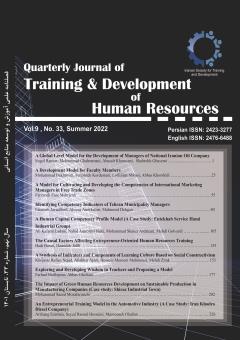Designing and validating the growth model of faculty members
Subject Areas :Mohammad bakhtiyari 1 , fereshteh kordestani 2 , lotfollah abbasi 3 , Abbas Khorshidi 4
1 - Higher Education Management, Faculty of Management, Islamic Azad University, Central Tehran Branch, Tehran, Iran
2 - Department of Educational Management and Higher Education, Faculty of Management, Islamic Azad University, Central Tehran Branch, Tehran, Iran
3 - Department of Educational Management and Higher Education, Faculty of Management, Islamic Azad University, Central Tehran Branch, Tehran, Iran.
4 - Department of Educational Management and Higher Education, Islamic Azad University, Islamshahr Branch, Tehran, Iran
Keywords: Pattern , maturity , faculty members , dimension,
Abstract :
This study was conducted to present the growth pattern of faculty members. The method of the present research in terms of practical objectives, In terms of data, it was an exploratory mix and in terms of nature and type of study, it was a cross-sectional survey. Research model based on studies Previously, inside and outside the country and the views of experts in this field were suggested. The statistical population of this research in the qualitative section 15 experts in the field of higher education and in a small dimension the faculty members of the Islamic Azad University, Tehran Branch Were central, and a sample of 280 of them identified by Morgan’s table. The main collection tool The data were first interviews with experts in this field and then the compilation of a seven-point questionnaire. Validity of measurement tools (CVR) and its validity was assessed and confirmed by Cronbach’s alpha. Pattern based on data analysis Optimally presented that has three dimensions: 1) Scientific abilities with a validity of %91 with three components of educational maturity, maturity Research, specialized maturity, 2) Personal abilities with a validity of %89 with two components: individual maturity, maturity Organizational 3) Spiritual / social abilities with a validity of %90 with two components of religious maturity and social maturity A total of 138 indicators had an effect on the growth of faculty members. This template can help managers and other professors Be a university.
1. Baldwin, R. G. (1990). Faculty career stages and implications for professional development. In J.H. Schuster, D. W. Wheeler. Et al. enhancing faculty careers. Strategies for development and renewal (pp.20-40). San Francisco: Jossey-Bass Publishers
2. Qoruneh, Davood (2014) Conceptual framework of faculty growth of Tehran University faculty. Iranian Higher Education Association Quarterly, 6 (2).p 45
3. Rosebohm, Kim M. (2020) Undergraduate faculty members: An Exploration of warring as instructional practice within two professional schools, University of Michigan-Flint.93
4. Jahangiri, Sadegh et al(2021). Explain the background model of strategies and consequences of competitive advantage based on the empowerment of faculty members and professors. Journal of Research in Educational Systems doi: 10.22034 / jiera.2021.268909.2445
5. Paripour, Azam et al. (2020) Provide a model for evaluating the quality of combined education in higher education based on the CIP evaluation approach. Journal of Research in Educational Systems, Volume 14, Number 51, Winter 2020, p.8
6. Feizi, Somayeh, Khorshidi Abbas, Hamidifar, Fatemeh, Salimi, Akbar, Delgshaei, Yalda (2016), Presenting the Productivity Model of the Faculty Members of Amin University of Law Enforcement Sciences, Journal of Law Enforcement Summer 2016 No. 2 Pages: 223-246
7. Soltani, Najmeh (2019), The growth model of faculty members of Payame Noor University based on informal learning using foundation data theory, Quarterly Journal of New Approach in Educational Management, 10 (4), Winter 2019, consecutive 4. Pages: 312- 342
8. Loura.K(2020). Maturity of members of the University of Arts. The case of Spanish university geolgists.Scientometrics, 55(1), 137-156.
9. Rayian.B(2019). Best Practices for Balancing Productivity and Job Satisfaction of Faculty Members. Research performance, collaboration, and time on research. Scientometrics, 85(2), 582-594.
10. Islamicization Council of Universities and Educational Centers (2011), Executive Instruction of the Regulations on Knowledge Enhancement and Empowerment of Academic Board Members of Universities, approved by Session 231. Dated 11/25/2011 http://iuec.ir
11. Supreme Council of the Cultural Revolution (2010), the document of the comprehensive scientific plan of the country.
http://sccr.ir/pages/simpleView.aspx?provID=1735
12. www.khamenei.ir
13. Bilal A, Salman Y, Guraya B, Songsheng C. The impact and effectiveness of faculty development program in fostering the faculty's knowledge, skills, and professional competence: A systematic review and meta-analysi. Saudi J Biol Sci. 2017
.


